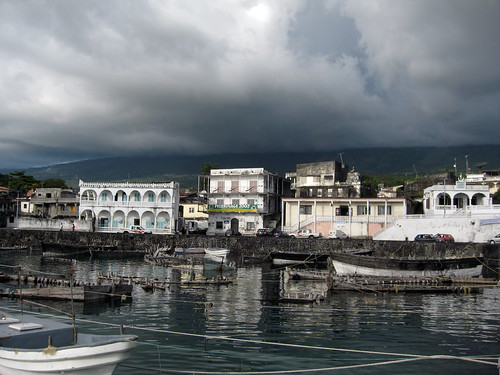
Moroni harbour, Grand Comore
Comoros is a nation of islands off the coast of Mozambique. The Comoros’ claim to fame is its production of 65% of the world’s perfume essence, which are extracted from the rich vegetation of jasmine, ylang-ylang, and orange blossoms. Comoros is also a cultivating center of various spices, including nutmeg, basil, cloves, vanilla, and peppers. Tourists, while they enjoy the sight of exotic vegetation, are more interested in the Comoros’ coral reefs, active volcanoes, excellent beaches, and water sports opportunities.
Comoros, as a country in Africa, consists of three main islands: Grande Comore (Ngazidja), Moheli (Mwali), and Anjouan (Nzwani). The volcanic Comoros archipelago actually includes a fourth main island, Mayotte (Mahore). Mayotte, however, voted against independence from France and is considered a French overseas territory, although the Comoros still lay claim to it. Besides the three main islands, Comoros also encompasses several smaller islets. Altogether, the land area of Comoros is just shy of 840 square miles.
The landscape of the Comoros is picturesque. Beaches and mangrove swamps line the coasts. The interior features mountain peaks that drop dramatically into deep valleys and steep ravines. Thick forests lush with green vegetation are found everywhere. The skyline of the islands is dominated by Mount Karthala, an active volcano that has the one of the world’s largest craters with a diameter that is more than two miles long.
Attractions
Beaches and Water Sports
There are many excellent beaches in Comoros. Some of the popular beaches include Bouni, Bimbini, Itsandra, Galawa Beach on Grande Comore, Fomboni Beach on Moheli, the palm-fringed Planet Plage, and Chomoni which is located near a sheltered bay. On Fomboni Beach, you can watch Arab sail boats being built.
There are also excellent diving areas, including the Trou du Prophete in Misamiouli on the island of Grande Comore and Niumashuwa Bay on the island of Moheli. The town of Mitsamiouli has some first-class diving facilities.
Those who enjoy fishing should visit Itsandra. Many of the ports in Comoros have boats and canoes that can be hired if you are looking to explore the various islands and islets.
Natural Features
Mount Karthala is an active volcano that has one of the largest still-active craters in the world. You can climb this volcano and stay overnight in the shelters that are provided.
Diziani Boundouni is a sulphurous crater lake at the center of the island of Moheli. It can be reached by fit hikers in a full day’s trek starting from the town of Fomboni.
Lac Sale are hot sulphur springs located in the 14th century village, Iconi.
There are a few waterfalls in Comoros, including one at Miringoni and another one on the island of Anjouan (Nzwani), which is forested with abundant vegetation.
Wildlife
Comoros is home to unique green turtles, best viewed by visiting the marine reserve off the southern coast of Moheli. You can take motorized pirogues canos operated by local fishermen from Niumashuwa. The Niumashuwa Bay itself is populated by giant turtles.
There are many bats and spiders on the island of Grand Comore in the town of Mitsamiouli.
Architecture
The capital Moroni on Grande Comore features government buildings, broad squares, market places, winding streets, and numerous mosques, including the Vendredi Mosque. The town of Mutsamudu has 17th century Swahili-Shirazi style architecture; you’ll find old houses with carved doors, mosques, citadels, and twisting alleyways.
People
Comoros is populated by a mix of Arabs and Africans who speak both Arabic and Swahili. The major religion in Comoros is Islam.
History
Comoros was known among sailors since ancient times and were run by the Arabs early on. The Portuguese reached the islands in the 16th century. They were followed by the French who colonized the islands. Comoros did not gain independence until 1975, but the island of Mayotte voted to remain part of France.
The first president of Comoros, Ahmed Abdallah, was overthrown almost immediately. But he turned in 1978 after organizing a coup. His reign lasted until 1989 when he was assassinated. The first multiparty elections were held in 1990.
Economic problems have plagued the country since its independence. Secessionist sentiments have been strong in the islands of Mwali (Moheli) and Nzwani (Anjouan). Both declared independence in 1997 and attempted to rejoin France, but the French refused. A series of military coups and bloody confrontations ensued. The recent 2006 elections were won by Ahmed Sambi, an election that has been honored by the previous president, Azali; this is the country’s first peaceful democratic exchange of power following a total of 18 military coups. Comorans hope that this is a sign of more peaceful and prosperous times ahead.


Comments